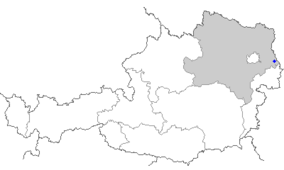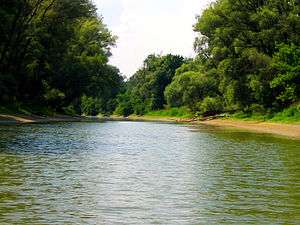Danube-Auen National Park
| Danube-Auen National Park | |
|---|---|
|
IUCN category II (national park) | |
|
Danube-Auen near Hainburg | |
 | |
| Location | Vienna and Lower Austria |
| Nearest city | Vienna |
| Coordinates | 48°8′0″N 16°55′0″E / 48.13333°N 16.91667°ECoordinates: 48°8′0″N 16°55′0″E / 48.13333°N 16.91667°E |
| Area | 93 km² |
| Established | October 27, 1996 |
The Danube-Auen National Park (German: Nationalpark Donau-Auen) covers 93 square kilometres in Vienna and Lower Austria and is one of the largest remaining floodplains of the Danube in Middle Europe.
The German word Aue (variant Au) means "river island, wetland, floodplain, riparian woodland", i.e. a cultivated landscape in a riparian zone. The words Aue and Au occur in a large number of German place names—including Donau, the German word for the Danube River—and refer to forests, meadows, and wetlands in river and stream lowlands and floodplains. The Danube-Auen National Park protects a large area of lowland forests, meadows, wetlands, and other riparian habitat along the Danube just downstream of Vienna.
The park was designated an IUCN category II national park and spans the areas of Vienna (Lobau), Groß-Enzersdorf, Orth an der Donau, Eckartsau, Engelhartstetten, Hainburg, Bad Deutsch-Altenburg, Petronell-Carnuntum, Regelsbrunn, Haslau-Maria Ellend, Fischamend and Schwechat.
Creation of the National Park
Until the 19th century the Danube was an untamed river. In the 19th century, extensive engineering began to alter the natural balance of the river landscape dramatically. Many side-channels were dammed so that they now carry water from the Danube only at flood stages. Ever more intrusive engineering interventions were accompanied by decades of heavy forestry use in many parts of lowland forests. In the 1950s, development began of an nearly unbroken chain of hydroelectric power plants and associated dams on the Austrian section of the Danube River.
In 1984, the planned construction of the Hainburg hydroelectric power plant, just downstream from Vienna, threatened the destruction one of two remaining free-flowing sections of the Danube in Austria and its riparian forests (the other remaining free-flowing section in Austria is upstream, near Wachau). An outcry by environmental and nature protection groups caused nationwide protests against the project. The operator of the power plant project disregarded the protests and began work to clear the area. Protests stepped up, eventually leading to the occupation of the Hainburg wetlands by thousands of people from all ages and professions (the so-called "Hainburg Movement"). After police tried several times to clear protestors from the area, in December 1984 the Federal Government declared a pause for reflection. In January 1985 the Austrian Supreme Court forbad further deforestation. In March 1985, the so-called Konrad Lorenz-Volksbegehren (petition), signed by 353,906 people, demanded the prohibition of large power plants such as Hainburg and the establishment of a national park in the area of Hainburg. On 1 July 1986, the Administrative Court released a decision cancelling the water rights of the planned power plant.
Extensive scientific studies were then made of the area, with surprising discoveries. More species of fish were observed than was known at the time the planning of the power plant.
The most important result of these studies was that the Danube lowlands area (Donau-Auen) in and east of Vienna was determined to be worthy of becoming a national park. It was also determined that creating a power plant in the area would not be compatible with national park status for the region. On October 27, 1996, a State Treaty between the Republic of Austria and the federal states of Vienna and Lower Austria was signed. With that treaty, the Danube-Auen National Park was officially opened.
Flora and fauna
In the national park area there are more than 700 species of higher plants, more than 30 mammals, 100 species of breeding birds, 8 reptiles, 13 amphibian species, and around 50 species of fish. Among the most characteristic inhabitants of the wetlands of the National Park are the Danube crested newt, the European pond turtle, dog fish, sea eagles, kingfishers, and beavers.
With the variety of insects living on both land and water, and other invertebrates, the total number of species in the Danube-Auen National Park is estimated to be at least 5,000.
External links
| Wikimedia Commons has media related to Nationalpark Donau-Auen. |
- www.donauauen.at (English)(German)

